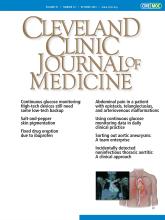ABSTRACT
Access to and use of glycemic data are central to optimal management of diabetes. Use of continuous glucose monitoring (CGM) data to guide the management of diabetes has increased dramatically thanks to improved ease of use, accuracy, and availability. Retrospective CGM data collected throughout the day and night allow clinicians to visualize glycemic patterns, and single-page summary views like the Ambulatory Glucose Profile (AGP) Report make rapid interpretation both feasible and intuitive. A systematic approach that integrates retrospective CGM-generated data at clinic visits and other clinical interactions with personal use of CGM data can optimize glycemic management.
- Copyright © 2024 The Cleveland Clinic Foundation. All Rights Reserved.
- Thomas W. Martens, MD⇑
- Medical Director, International Diabetes Center, HealthPartners Institute, Minneapolis, MN; Consultant, Department of Internal Medicine, Park Nicollet Clinic Brooklyn Center, MN
- Address:
Thomas W. Martens, MD, International Diabetes Center, Health-Partners Institute, Suite 600, 3800 Park Nicollet Blvd., Saint Louis Park, MN 55416; Thomas.martens{at}parknicollet.com
- Gregg D. Simonson, PhD
- Richard M. Bergenstal, MD
ABSTRACT
Access to and use of glycemic data are central to optimal management of diabetes. Use of continuous glucose monitoring (CGM) data to guide the management of diabetes has increased dramatically thanks to improved ease of use, accuracy, and availability. Retrospective CGM data collected throughout the day and night allow clinicians to visualize glycemic patterns, and single-page summary views like the Ambulatory Glucose Profile (AGP) Report make rapid interpretation both feasible and intuitive. A systematic approach that integrates retrospective CGM-generated data at clinic visits and other clinical interactions with personal use of CGM data can optimize glycemic management.
- Copyright © 2024 The Cleveland Clinic Foundation. All Rights Reserved.






